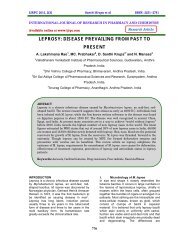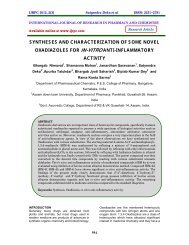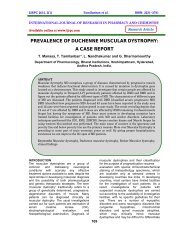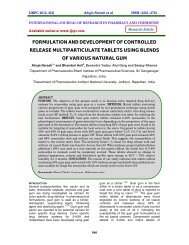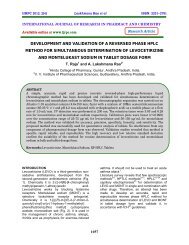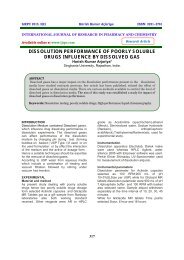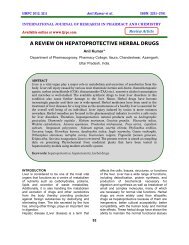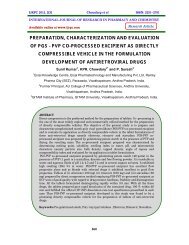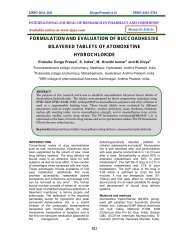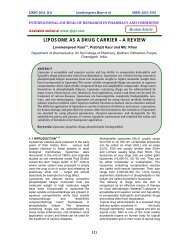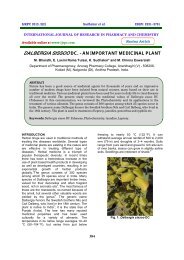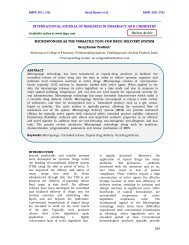LITSEA CHINENSIS LAM - ijrpc
LITSEA CHINENSIS LAM - ijrpc
LITSEA CHINENSIS LAM - ijrpc
Create successful ePaper yourself
Turn your PDF publications into a flip-book with our unique Google optimized e-Paper software.
IJRPC 2012, 2(2) Bhatt et al ISSN: 22312781<br />
INTERNATIONAL JOURNAL OF RESEARCH IN PHARMACY AND CHEMISTRY<br />
Available online at www.<strong>ijrpc</strong>.com<br />
Research Article<br />
SCANNING ELECTRON MICROSCOPY OF LEAF OF<br />
<strong>LITSEA</strong> <strong>CHINENSIS</strong> <strong>LAM</strong><br />
Bhatt SP 1* and Pandya SS 2<br />
1 Jodhpur National University, Jodhpur, Rajasthan, India.<br />
2<br />
B. Pharmacy College, Kakanpura, Godhra, Panchmahal, Gujarat, India.<br />
ABSTRACT<br />
Microscopic structure of Litsea chinensis Lam was studied with the help of scanning electron<br />
microscope for pharmacognostical and taxonomic utility. Despite its wide distribution and<br />
medicinal use, it has little attention on microscopy reported in literature. It has homogenous and<br />
characteristic leaf anatomy. Presence of abundant mucilage, developed vascular bundle,<br />
hypodermis, presence of ground material and tissues might eventually allow recognition and<br />
standardization of plant.<br />
Keywords: Leaf anatomy, Litsea chinensis Lam, Lauraceae, SEM<br />
INTRODUCTION<br />
The scanning electron microscope (S.E.M.)<br />
with its relatively high resolution and great<br />
depth of focus, far surpassing that of the light<br />
microscope, is an important addition to the<br />
range of techniques available for structural<br />
studies in biology. Thus far this instrument has<br />
produced its most impressive results on the<br />
fine architecture of the surfaces of hard tissues<br />
which do not require complex histological<br />
techniques. 1<br />
Although some results merely confirm previous<br />
light microscope studies, the SEM has made it<br />
possible to elucidate the real nature of many<br />
features lying at or beyond the limit of<br />
resolution of the light microscope and at the<br />
same time revealed many, completely<br />
unsuspected, new structures.<br />
To date, in the botany, the SEM has been<br />
utilized in fields such as wood, seed, fruit, and<br />
spore anatomy, palynology, palaeobotany, and<br />
the study of the distribution and physical<br />
1,2<br />
nature of the cuticular layers of leaves.<br />
Detailed studies have been made on diverse<br />
groups ranging from the angiosperms to the<br />
algae and fungi, bryophytes by comparison<br />
have been rather neglected. The surface<br />
topography of a few spores has been<br />
examined. 3,4<br />
The scanning electron microscope (S.E.M.)<br />
gives considerable depth of focus at high<br />
magnification, an advantage over the light<br />
microscope. 5<br />
It was therefore thought useful to examine the<br />
histology of leaf of Litsea chinensis Lam with<br />
S.E.M.<br />
Litsea chinensis Lam (syn: Litsea glutinosa) is<br />
a Lauraceae member commonly known as<br />
Meda lakadi in Hindi, Medsakhah in Sanskrit,<br />
Neluka in Assami and Meda or Va Lakdi in<br />
local Gujarati language. Plant is believed to be<br />
effective for its wound healing, antidiarrhoeal,<br />
and anti-inflammatory property in traditional<br />
and folk lore system of medicine. 6-10 Yet so far<br />
scanty of anatomical studies of the leaf for the<br />
Litsea chinensis Lam reported. This study<br />
reports the anatomical characterization of leaf<br />
of Litsea chinensis Lam with Scanning<br />
Electron Microscope. Leaf histology was<br />
studied to see useful features for<br />
distinguishing between plant species,<br />
standardisation in plants known to have similar<br />
structure.<br />
MATERIALS AND METHODS<br />
Study and collection of plant<br />
Leaf samples were collected from the vicinity<br />
of Jorhat, Assam. Preliminary data provided by<br />
Medicinal and aromatic plant Department of<br />
470
IJRPC 2012, 2(2) Bhatt et al ISSN: 22312781<br />
north east institute of science and technology<br />
of Jorhat indicated that the place, environment<br />
and habitat were meteorological near the<br />
Jorhat were climate and environments were<br />
suitable.<br />
Taxonomic authentification<br />
Taxonomic determination — Litsea<br />
chinensis Lam has been identified and<br />
collected from the vicinity of Jorhat. Of the so<br />
many variety of Litsea present in Assam, to<br />
determine the species found at the study sites,<br />
blooming trees were chosen at the area.<br />
Vouchers were prepared and submitted in the<br />
Herbarium at the Botanical Survey of India,<br />
North East Region, Shillong, Meghalaya.<br />
Herbarium was examined for cross-reference<br />
using the taxonomic identification key and the<br />
plant was identified as Litsea chinensis Lam.<br />
Sampling — Samples were obtained from the<br />
well developed trees site, at 3 m from the<br />
ground by direct plucking method. The<br />
anatomical description was based on well<br />
known botanical literature.<br />
Preparation for SEM<br />
For observations by scanning electron<br />
microscopy, fragments of about 5 mm square<br />
of the leaves and was washed, at room<br />
temperature and fixed on aluminum probe unit.<br />
Observations were carried in crayo (constant<br />
pressure) mode with the help of German made<br />
SEM Leo1 1430VP, version 1. Samples were<br />
examined in constant temperature -10 0 C at<br />
variable distance.<br />
RESULT AND DISCUSSION<br />
General anatomy of leaf<br />
Externally, the leaf was green with well<br />
developed epipodium, mesopodium and<br />
hypopodium. It was foliage leaf arranged<br />
alternatively. Hopopodium exhibited base and<br />
stipules. Petiole was symmetrical. Leaf was<br />
lanceolate, glabrous, coriaceous, pinnate<br />
venation with entire margin and acute apex; of<br />
variable in size (L:16-26 cm x B: 4-8cm) It<br />
smells characteristic and taste mucilaginous.<br />
Depending from stem maturity, leaf exhibits<br />
variable size and maturity fig. 1.<br />
Microscopy of the leaf<br />
The leaf was dorsiventral. It consists of lamina<br />
and midrib. Both are distinctive and well<br />
developed. Several ridges and furrows were<br />
present in upper and lower part of the midrib<br />
(Fig. 2a).<br />
Lamina<br />
Entire lamina measured 108.3 µm in size (Fig.<br />
2b). Cuticle, upper and lower epidermis,<br />
palisade tissue layer, parenchymetous cells<br />
and vascular bundles were present and well<br />
developed.<br />
Epidermis<br />
There were two epidermial layers on abaxial<br />
and adaxial surfaces of the leaf. Each was<br />
uniseriate, composed of a row of compactly<br />
set rectangular or squarish cells and have thin<br />
and sinuous cell walls on adaxial and abaxial<br />
surfaces. The cells measured 11.36 µm x 4.90<br />
µm in size. The outer walls were cutinised and<br />
possess thin cuticle. The thickness was being<br />
more pronounced in the cells of the upper<br />
epidemis 7.401 µm than those on the lower<br />
side 3.3 µm (Fig. 3a & 3b.).<br />
Trichomes<br />
Eglanduate of 53.47 µm and glanduate of<br />
128.8 µm size, unicellular warty sometimes<br />
filliform trichomes were present on both the<br />
surface of lamina and midrib (Fig. 3c & 3d.).<br />
Eglanduate trichomes have thick cell wall and<br />
pointed apex.<br />
Stomata<br />
Stomata of anisocytic type was present<br />
abundantly on upper surface while less in<br />
lower surface. An arrangement of guard cells<br />
and subsidiary cells or accessory cells was<br />
readily distinguished from adjacent epidermal<br />
cells. The stomata measured 13.28 µm X3.34<br />
µm (Fig. 3e & 3f).<br />
Mesophyll<br />
Lamina was dorsiventral. The ground tissues<br />
forming the mesophyll, was differentiated into<br />
palisade and spongy cells. The palisade cells<br />
occur towards upper epidermis. Average size<br />
of palisade cells measured 9.892 µm x 24.45<br />
µm (Fig. 3g). They were columnar cells with<br />
scanty intercellular spaces and remains<br />
arranged more or less at right angles to the<br />
upper epidermis. Abundant chloroplasts were<br />
present. There were two layers of palisade<br />
cells. The spongy cells occur towards the<br />
lower epidermis. These cells were oval,<br />
spherical or irregular in shape. They were<br />
quite loosely arranged with conspicuous<br />
intercellular spaces. The number of chloroplast<br />
was much less here which explains the pale<br />
green colour of the lower surface of the leaf.<br />
Vascular bundles were present in lamina. The<br />
bundles were surrounded by the parenchyma<br />
cells.<br />
471
IJRPC 2012, 2(2) Bhatt et al ISSN: 22312781<br />
Midrib<br />
In TS, midrib was broader and well developed.<br />
Entire midrib measured 261.2 um in size (Fig.<br />
2b). The midrib had the following zones, outer<br />
epidermis, followed by hypodermis of<br />
collenchyma, parenchymetous ground zone,<br />
bands of ground tissues, centrally located<br />
vascular zone (Fig. 2b) Upper epidermis and<br />
lower epidermis were found similar to lamina.<br />
Midrib has uniseriate epidermis of squarish or<br />
rectangular cells on adaxial and abaxial<br />
surface. Top of midrib had two shallow<br />
longitudinal groves on the adaxial surfaces<br />
and several ridges and furrow on the abaxial<br />
surface. Photograph no. 3.18 proves presence<br />
of furrow and groves in midrib. Trichomes and<br />
cuticle were also observed on abaxial and<br />
adaxial surface. Their structure and type was<br />
resemblance to lamina.<br />
Cortex<br />
Adaxial and abaxial hypodermises were<br />
composed of collenchyma cells and bands of<br />
sclerenchyma cells are present. A distinctive<br />
layer of cambium was present. Cortex was<br />
parenchymetous. Area of Hypodermis was<br />
small due to well developed vascular bundle,<br />
growth of the secondary layers in vascular<br />
bundles. Fig. 2b illustrates its presence and<br />
character.<br />
Vascular bundle<br />
The vascular bundles were centrally located<br />
and well developed. The vascular bundle of<br />
midrib consists of a single large central colateral<br />
vascular bundle. Xylem and phloem<br />
remain side by side arranged on the same<br />
radius. Phloem arranged on the outer side i.e.<br />
external and xylem arranged towards<br />
endodermis or centre. Abundant mucilage was<br />
present in the region of vascular bundle that<br />
confirm by blue colour (Fig. 2b)<br />
Xylem<br />
Xylem and xylem parenchyma were well<br />
developed. Tracheae found tube like structure<br />
suited for the conductance of water and<br />
solutes. A xylem vessel was of annular and<br />
circular type. Diameter of sample unit Xylem<br />
measured 12.22 µm and 13.68 µm (Fig. 2b,<br />
4b, 4c.). Like other dicots, in the present<br />
species also Metaxylem was observed<br />
towards the centre and protoxylem towards<br />
peripherals. Secondary xylem and trachides<br />
were present. Mechanical or ground tissues of<br />
6.672 µm inner diameter were present.<br />
Phloem<br />
Phloem and secondary phloem were well<br />
developed. A band of thick walled fibers was<br />
observed the abaxial side of phloem of the<br />
vascular bundle. There was an evidence of<br />
vascular bundle. Phloem character portrayed<br />
well in Fig. 2b, 4d.<br />
Other characters<br />
Stellate crystal or druses of calcium oxalate<br />
and starch grain were present in the region of<br />
cortex that evident by the simple microscopy.<br />
DISCUSSION<br />
The results of leaf anatomy and foliar<br />
characters, especially vascular system,<br />
trichome types, and localization of crystals<br />
were of surprisingly high systematic value<br />
proposed based on SEM. The surface<br />
topography examined in detailed relief and the<br />
internal architecture is revealed by scanning<br />
cut surfaces to look inside and exposed cells.<br />
The stereoscopic nature of the observations<br />
enables to comprehend the organization of<br />
cells and tissues in the solid and at higher<br />
magnifications, the detailed architecture of cell<br />
wall and contents. Observations made by light<br />
microscopy can be supplemented or scanning<br />
investigations may be sufficiently<br />
comprehensive to establish criteria<br />
independently. In either case entirely new<br />
information was recorded by this method for<br />
Litsea chinensis Lam. Apart from the<br />
improvement brought about by the accessory<br />
instruments and apparatus, specialised<br />
techniques have been developed for preparing<br />
and handling materials especially difficult to<br />
study in light microscope. At present, SEM<br />
with TEM and elemental detection facility is<br />
currently giving a long needed boost to<br />
researchers.<br />
Inevitably, this paper has developed to study<br />
SEM of Litsea leaf although; SEM study was<br />
never intended to be comprehensive. The<br />
spectacular illustrations of leaf structure,<br />
beautifully produced, indicate the scope of the<br />
SEM in the study of plant anatomy, and, at the<br />
same time, plenty of literature stresses its<br />
importance as a medium of communication.<br />
Micrographs such as these will benefit to<br />
taxonomist and readers not only limited to<br />
study but also standardise the drug.<br />
CONCLUSION<br />
Leaf microscopy alone does not allow<br />
distinguishing and standardising Litsea<br />
species from one to other. The similarity in leaf<br />
structure best be distinguished under higher<br />
resolution. Following observations appears<br />
important anatomical characters in microscopy<br />
of Litsea chinensis Lam leaf. Consequently,<br />
different species can not solely distinguished<br />
and reliable on leaf only but need concomitant<br />
472
IJRPC 2012, 2(2) Bhatt et al ISSN: 22312781<br />
study of different parts. Therefore, further<br />
detailed study appears to be the most<br />
promising feature for further study.<br />
A study reports the SEM study of the leaf of<br />
Litsea chinensis Lam. The following<br />
characteristics were outstanding.<br />
1. The leaf was dorsiventral, petiolate, with<br />
acute apex, coracious texture, glabrous<br />
surface and entire margin.<br />
2. There were numerous stellate crystals of<br />
calcium oxalate.<br />
3. Abundant mucilage and gum was present.<br />
4. Eglanduate and uniseriate warty trichomes<br />
were present over the upper and lower<br />
epidermis<br />
5. Collateral vascular bundles were well<br />
developed.<br />
6. Collenchymatous hypodermis was smaller<br />
in area due to well developed vascular<br />
bundles.<br />
7. Anisocytic stomatas was present in<br />
abundant on upper surface<br />
8. Secondary xylem and phloem were<br />
present.<br />
9. Collenchymas and ground tissues were<br />
present, well developed.<br />
ACKNOWLEDGEMENT<br />
We wish to acknowledge the assistance and<br />
support of Dr. A.K. Bhatt in the scanning<br />
electron microscopy facilities provided at the<br />
Analytical Department, CSMCRI, Bhavnagar,<br />
Gujarat, India.<br />
Fig. 1: Litsea chinensis Lam Tree and gross appearance of leaf (inset)<br />
Fig. 2a: Scanning Electron Micrograph of leaf of L. chinensis Lam<br />
473
IJRPC 2012, 2(2) Bhatt et al ISSN: 22312781<br />
Fig. 2b: Midrib in Scanning Electron Micrograph of leaf of L. chinensis Lam<br />
Fig. 3a: Cuticle and upper epidermis and hypodermis of collenchyma<br />
in Scanning Electron Micrograph of leaf of L. chinensis Lam<br />
Fig.3b: Cuticle and lower epidermis in Scanning Electron<br />
Micrograph of leaf of L. chinensis Lam<br />
474
IJRPC 2012, 2(2) Bhatt et al ISSN: 22312781<br />
Fig. 3c: Scanning Electron Micrograph of unicellular uniseriate trichomes (Uniseriate<br />
type, 53.47 um) in dermis of foliage leaf of Litsea chinensis Lam<br />
Fig. 3d: Trichomes (glandular type, 128um) in lower epidermis in Scanning Electron<br />
Microscopy of leaf of L. chinensis Lam<br />
Fig. 3e: Scanning Electron Micrograph of Stomata in upper epidermis of leaf of L.<br />
chinensis Lam<br />
475
IJRPC 2012, 2(2) Bhatt et al ISSN: 22312781<br />
Fig. 3f: Scanning Electron Micrograph of Stomata in<br />
upper epidermis of leaf of L. chinensis Lam<br />
Fig. 3g: Arrangement and size of palisade tissue in Scanning<br />
Electron Micrograph of L. chinensis Lam<br />
Fig.4a: Vascular bundles with elements (xylem and phloem) & size in Scanning<br />
electron micrograph of leaf of L. chinensis Lam<br />
476
IJRPC 2012, 2(2) Bhatt et al ISSN: 22312781<br />
Fig.4b: Arrangement of xylem and material in Scanning<br />
Electron Micrograph of leaf of L. chinensis Lam<br />
Fig.4c: xylem (type & size arrangement) in Scanning Electron Micrograph of leaf of L.<br />
chinensis Lam<br />
Fig. 4d: Trachides and cell wall thickening in Scanning Electron Micrograph of leaf of L.<br />
chinensis Lam<br />
477
IJRPC 2012, 2(2) Bhatt et al ISSN: 22312781<br />
REFERENCES<br />
1. Carr KE. Applications of scanning<br />
electron microscopy in biology.<br />
Internat. Rev. Cytol. 1971;30: 183-<br />
255.<br />
2. Stant MY. The role of scanning<br />
electron microscope in plant anatomy.<br />
Kew bulletin 1973;28(1):105-115.<br />
3. Mozingo H, Klein P, Zeevi Y, Lewis<br />
ER. Scanning electron microscope<br />
studies on Sphagnum imbricatum.<br />
The Bryologist. 1969;72:484-488.<br />
4. Taylor J, Kaufman PB and Bigelow<br />
WC. Scanning electron microscope<br />
examination of spore and elaters of<br />
Targionia hypophylla. The Bryologist.<br />
1972;74:497-498.<br />
5. McNeil KE and Skerman VBD.<br />
Examination of Myxobacteria by<br />
scanning electron microscopy.<br />
International Journal of Systemic<br />
Bacteriology. 1972;22(4):243-250.<br />
6. Bennet SSR. “Name changing in<br />
flowering plants of India and adjacent<br />
regions”, Treaser Publisher, Dehra<br />
Dun. 1986; 339-40.<br />
7. Bora PJ. Yogendra Kumar., “Floristic<br />
diversity of Assam; study of pabitora<br />
wildlife santury”, Daya publishing<br />
house, Assam. 2003Page no. 291.<br />
8. Kirtikar KR and Basu BD. Indian<br />
medicinal plants Vol:III. International<br />
Book Distributors, Dehradun.<br />
2005.;2157-2161.<br />
9. Dept. of Ayurveda, Yoga, Unani,<br />
Sidhha and Homeopathy, New Delhi,<br />
Ministry of Health and Family Welfare.<br />
Govt. of India. The Ayurvedic<br />
Pharmacopoeia of India 2006; 1st<br />
Edn, Part –I, Vol; V.108-9.<br />
10. Cooke T. “Flora of the presidency of<br />
Bombay”, Vol III, 2 nd Edn, Botanical<br />
Survey of India, Govt. of Indian. Page<br />
no 31-33<br />
478



